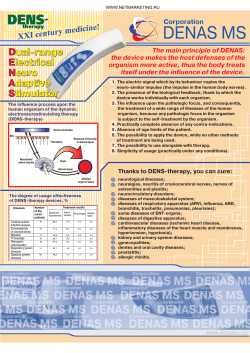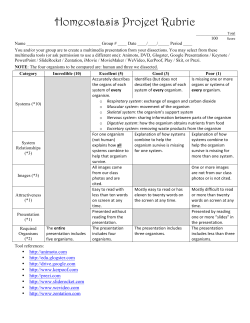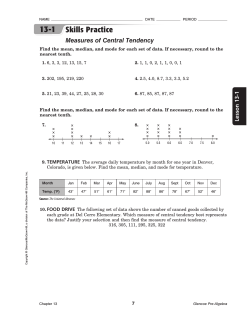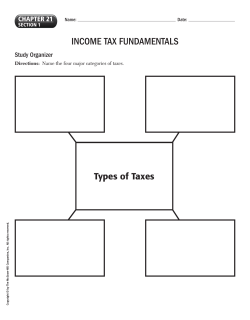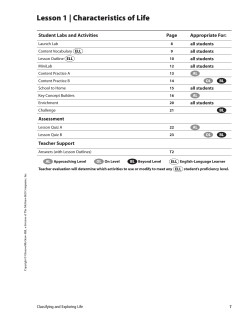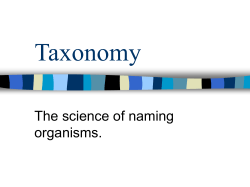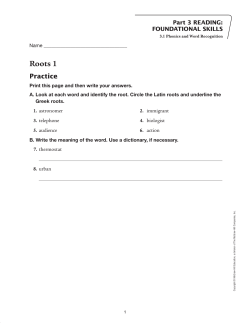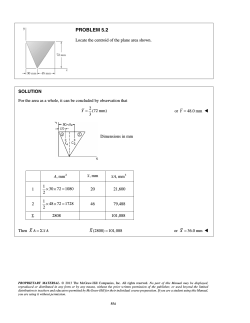
Lesson 2 | Levels of Organization
Lesson 2 | Levels of Organization Student Labs and Activities Page Appropriate For: Launch Lab 28 all students Content Vocabulary ELL 29 all students Lesson Outline ELL 30 all students MiniLab 32 all students Content Practice A 33 AL AL AL Content Practice B 34 AL OL BL School to Home 35 Key Concept Builders 36 Enrichment 40 Challenge 41 AL AL BL Lab A 44 AL AL AL Lab B 47 AL OL BL Lab C 50 AL AL BL Chapter Key Concepts Builder 51 AL AL AL Lesson Quiz A 42 AL AL AL Lesson Quiz B 43 AL OL BL Chapter Test A 52 AL AL AL Chapter Test B 55 AL OL AL Chapter Test C 58 AL AL BL all students AL AL AL all students Copyright © Glencoe/McGraw-Hill, a division of The McGraw-Hill Companies, Inc. Assessment Teacher Support Answers (with Lesson Outlines) AL Approaching Level T4 OL On Level BL Beyond Level ELL English-Language Learner Teacher evaluation will determine which activities to use or modify to meet any ELL student’s proficiency level. From a Cell to an Organism 27 Name Date Launch Lab Class LESSON 2: 15 minutes How is a system organized? The places people live are organized in a system. Do you live in or near a city? Cities contain things such as schools and stores that enable them to function on their own. Many cities together make up another level of organization. Procedure 1. Read and complete a lab safety form. 4. Cut out the City, Continent, Country, 2. Using a metric ruler and scissors, County, and State labels your teacher gives you. measure and cut squares of construction paper that are 4 cm, 8 cm, 12 cm, 16 cm, and 20 cm on each side. Use a different color for each square. 3. Stack the squares from largest to 5. Use a glue stick to attach the City label to the smallest square. Sort the remaining labels from smallest to largest, and glue to the corresponding square. smallest, and glue them together. Think About This 1. What is the largest level of organization a city belongs to? 3. Key Concept How do you think the system used to organize where people live is similar to how your body is organized? 28 From a Cell to an Organism Copyright © Glencoe/McGraw-Hill, a division of The McGraw-Hill Companies, Inc. 2. Can any part of the system function without the others? Explain. Name Date Class Content Vocabulary LESSON 2 Levels of Organization Directions: In the puzzle below, each number will correspond to one letter of the alphabet. For example, 10 = E. Shaded letters will not be used. Crack the code by using the clues for hints. After you read the clues and fill in the blanks, complete the chart with the number that corresponds to each letter you have used. A B C D E F G H I J K L M S T U V W X Y Z 1 21 10 N O P Q R 1. a cell that can develop into many different cell types 23 24 E 10 3 16 E 10 20 20 2. a long muscle cell 18 1 7 E 10 4 Copyright © Glencoe/McGraw-Hill, a division of The McGraw-Hill Companies, Inc. 3. the process by which cells become different types of cells 16 13 E 10 1 20 18 20 18 E 10 4 E 10 25 24 1 6 24 24 E 10 3 25 4. a group of different organs that work together 21 4 2 6 25 23 8 23 5. a group of similar types of cells that work together 24 1 23 23 12 E 10 6. a group of tissues that work together 21 4 2 6 25 7. made of two or more parts 16 21 3 From a Cell to an Organism 11 20 E 10 26 29 Name Date Class Lesson Outline LESSON 2 Levels of Organization A. Life’s Organization 1. A large animal is composed of trillions of tiny working together. 2. organisms are made of only one cell. B. Unicellular Organisms 1. Unicellular organisms are or prokaryotes. 2. A cell without a membrane-bound nucleus is a(n) cell. 3. A(n) cell has a nucleus surrounded by a membrane and many other specialized organelles. C. Multicellular Organisms 1. Each type of cell in a multicellular organism has a specific job that is important to the of the organism. 2. Cells become different types during . a. Nearly all the cells in an organism have identical b. Different types of cells use of the chromosome. are unspecialized cells that can develop into many different cell types. 4. Stem cells can produce new muscle cells when are torn. 5. In plants, unspecialized cells similar to animal stem cells are grouped in areas called 6. . are groups of similar types of cells that work together to carry out specific tasks. a. Most animals have four main types of tissue—muscle, epithelial, nervous, and . b. The three main types of plant tissue are dermal, , and ground tissue. 7. jobs in organisms require more than one type of tissue. 8. are groups of different tissues working together to perform a particular job. The leaf is a(n) in photosynthesis. 30 that specializes From a Cell to an Organism Copyright © Glencoe/McGraw-Hill, a division of The McGraw-Hill Companies, Inc. 3. . Lesson Outline continued 9. are groups of different organs that work together to complete a series of tasks. a. One human organ system, the , includes the stomach and intestines. b. Plants have two major organ systems—the shoot system and the c. system. organisms usually have many organ systems. d. Each organ system on the others and cannot work Copyright © Glencoe/McGraw-Hill, a division of The McGraw-Hill Companies, Inc. alone. From a Cell to an Organism 31 Name Date MiniLab Class LESSON 2: 25 minutes How do cells work together to make an organism? In a multicellular organism, similar cells work together and make a tissue. A tissue can perform functions that individual cells cannot. Tissues are organized into organs, then organ systems, then organisms. How can you model the levels of organization in an organism? Procedure 1. Read and complete a lab safety form. 2. Your teacher will give you a cardboard shape, macaroni, and a permanent marker. 3. The macaroni represents cells. Use the marker to draw a small circle on each piece of macaroni. This represents the nucleus. 4. Arrange and glue enough macaroni pieces on the blank side of the cardboard shape to cover it. Your group of similar cells represents a tissue. 5. One of the squares on the back of your shape is labeled A, B, C, or D. Find the group that has the matching letter. Line up these squares, and use tape to connect the two tissues. This represents an organ. 6. Repeat step 4 with the squares labeled E or F. This represents an organ system. 7. Connect the organ systems by aligning the squares labeled G to represent an organism. 1. Each group had to work with other groups to make a model of an organism. Do cells, tissues, and organs need to work together in organisms? Explain. 2. Key Concept How does your model show the levels of organization in living things? 32 From a Cell to an Organism Copyright © Glencoe/McGraw-Hill, a division of The McGraw-Hill Companies, Inc. Analyze and Conclude Name Date Class Content Practice A LESSON 2 Levels of Organization Directions: On the line before each definition, write the letter of the term that matches it correctly. Each term is used only once. 1. a cell that can become many different cell types A. cell differentiation 2. a group of similar cells that work together to B. stem cell carry out a specific task 3. a group of different organs that work together to complete a series of tasks 4. the process by which cells becomes different C. tissue D. organ E. organ system F. organism types of cells 5. a group of organ systems that carry out all the jobs needed for their survival 6. a group of different tissues working together to perform a particular job Directions: Circle the term in parentheses that correctly completes each sentence. Copyright © Glencoe/McGraw-Hill, a division of The McGraw-Hill Companies, Inc. 7. Cells work together in a (multicellular/unicellular) organism. 8. A cell in a (multicellular/unicellular) organism must carry out all the activities that are necessary to survive. 9. Different types of cells in a multicellular organism have (different/the same) chromosomes. 10. Multicellular organisms are (eukaryotes/prokaryotes). From a Cell to an Organism 33 Name Date Class Content Practice B LESSON 2 Levels of Organization Directions: Answer each question or respond to each statement on the lines provided. 1. How are unicellular organisms and multicellular organisms the same? 2. How are a unicellular organism and a multicellular organism different? 3. What is cell differentiation? Why is it important? Copyright © Glencoe/McGraw-Hill, a division of The McGraw-Hill Companies, Inc. 4. Explain how stem cells are necessary for cell differentiation. 5. Compare what makes up cells, tissues, organs, and organ systems. 34 From a Cell to an Organism Name Date School to Home Class LESSON 2 Levels of Organization Did you know? Cells make up tissues in organisms, and tissues are organized into organs and organ systems. Cells are differentiated, which means they have different structures and carry out specific functions. For this activity, you will design an investigation of an aspect of cell structure or function that interests you. 1. Write a Question Think about what interests you in the roles cells play in the functions of different tissues. Write a question that will be the basis of your investigation. 2. Form a Hypothesis Based on what you know about cells and tissues, what do you Copyright © Glencoe/McGraw-Hill, a division of The McGraw-Hill Companies, Inc. think the answer to your investigation question will be? Write your hypothesis below. 3. Develop a Method Determine the best method to answer your investigation question. What will you look for? Write your method below. 4. Collect Data Describe your data collection plan below. 5. Plan for Problems Describe how you will deal with a potential problem with the investigation. From a Cell to an Organism 35 Name Date Key Concept Builder Class LESSON 2 Levels of Organization Key Concept How do unicellular and multicellular organisms differ? Directions: In the space at the left, write U next to each statement that correctly identifies unicellular organisms. Write M next to each statement that identifies multicellular organisms. Write B next to each statement that applies to both organisms. 1. These organisms consist of cells. 2. Each cell must carry out all life processes. 3. Cells are specialized and perform specific functions. 4. These organisms can be prokaryotes or eukaryotes. 5. These organisms are always eukaryotes. 6. Cells in these organisms differentiate. 7. These organisms have stem cells. 8. These organisms have tissues. Directions: Respond to each statement on the lines provided. 10. Use your responses above to summarize the main differences between a unicellular organism and a multicellular organism. 36 From a Cell to an Organism Copyright © Glencoe/McGraw-Hill, a division of The McGraw-Hill Companies, Inc. 9. Compare a prokaryotic cell and a eukaryotic cell. Name Date Class Key Concept Builder LESSON 2 Levels of Organization Key Concept How does cellular differentiation lead to the organization within a multicellular organism? Directions: Use the terms from the word bank to order the levels of organization from smallest to largest. Then write a definition of each term on the lines provided. cell organ organism organ system tissue 1. Definition: 2. Definition: Copyright © Glencoe/McGraw-Hill, a division of The McGraw-Hill Companies, Inc. 3. Definition: 4. Definition: 5. Definition: From a Cell to an Organism 37 Name Date Class Key Concept Builder LESSON 2 Levels of Organization Key Concept How does cellular differentiation lead to the organization within a multicellular organism? Directions: Answer each question or respond to each statement on the lines provided. 1. What is a stem cell? 2. What is the process by which cells become different types of cells? 3. Why are stem cells in an embryo important? 4. Why are adult stem cells important? 6. What are unspecialized cells in plants called? Where are they located? 7. Compare the chromosomes in a skin cell to a muscle cell in the same organism. Include an explanation of how the two types of cells can be different. 38 From a Cell to an Organism Copyright © Glencoe/McGraw-Hill, a division of The McGraw-Hill Companies, Inc. 5. Give examples of where adult stem cells are located in people. Name Date Class Key Concept Builder LESSON 2 Levels of Organization Key Concept How does cellular differentiation lead to the organization within a multicellular organism? Directions: Answer each question or respond to each statement on the lines provided. 1. List the four main types of tissues in humans. Then explain why the stomach has all four types of tissues. 2. List the three main types of tissues in plants. Then describe the function of each type Copyright © Glencoe/McGraw-Hill, a division of The McGraw-Hill Companies, Inc. of tissue. 3. What do the stomach and a leaf have in common? 4. What do the human circulatory system and a plant’s shoot system have in common? 5. Why do multicellular organisms have more that one organ system? From a Cell to an Organism 39 Name Date Enrichment Class LESSON 2 Stem-Cell Treatments Until recently, scientists thought that the central nervous system could not repair itself. Damage to this human body system was thought to be permanent. New research, however, has opened the door to treating injuries and diseases of the central nervous system. Some of this research focuses on embryonic stem (ES) cells. Unspecialized Cells A Controversial Treatment ES cells that are programmed as nerve or brain cells could be used to treat spinal cord injuries, which occur to approximately 11,000 Americans each year. In addition, they could potentially be used to treat Alzheimer’s and Parkinson’s diseases. However, ES cells are often taken from Looking Ahead Scientists are encouraged by their rapid progress with ES cell treatment. However, many years of experimentation and research lie ahead. Moral and ethical issues must be addressed as well. In the meantime, people who have sustained damage to their central nervous systems continue to hold out hope for a long-term cure. Applying Critical-Thinking Skills Directions: Respond to each statement. 1. Explain which characteristic of stem cells makes them suited to treating injuries or diseases of the central nervous system. 2. Compose Use of ES cells remains a controversial issue. Write a letter to a newspaper editor explaining your views on this issue. Support your letter with facts from the article. 40 From a Cell to an Organism Copyright © Glencoe/McGraw-Hill, a division of The McGraw-Hill Companies, Inc. Recall that stem cells are unspecialized cells that can develop into many different cell types. Scientists have found that ES cells from fetal tissue have the potential to develop into nearly every kind of cell in the human body. They are “unprogrammed” cells that can take on the characteristics of specialized cells, including nerve or brain cells that do not readily repair themselves. This means ES cells might be able to repair nerves, grow tissues, or grow entire organs. aborted fetuses or from embryos made in test tubes. Thus, use of ES cells raises ethical and moral issues. Scientists have attempted to address these issues by using ES cells from the embryos of animals such as mice and hamsters. For example, using adult rats with damaged spinal cords, scientists have found that transplanted ES cells triggered the production of myelin. Myelin is the protective coating that insulates nerves. This coating is often damaged or destroyed in the nerves of people with spinal cord injuries. If the coating were restored, the function of the nerve might also be restored. For people confined to a wheelchair, that could mean regaining the movement of a limb or control of bladder function. Name Challenge Date Class LESSON 2 Organ Systems Copyright © Glencoe/McGraw-Hill, a division of The McGraw-Hill Companies, Inc. Your are an illustrator working for a small company. A client has asked for an illustration of one of the different organ systems that work together to make the human body function. Your supervisor has asked you to research an organ system of your choice. You must sketch the organ system, describe its function, and include captions and labels that identify the major organs, tissues, and cells. This is a rush job, so you have only three days to complete your assignment. From a Cell to an Organism 41
© Copyright 2025

